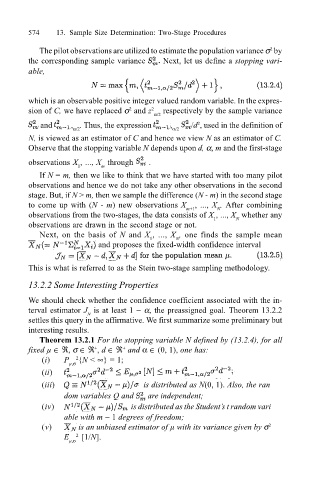Page 597 - Probability and Statistical Inference
P. 597
574 13. Sample Size Determination: Two-Stage Procedures
The pilot observations are utilized to estimate the population variance σ by
2
the corresponding sample variance Next, let us define a stopping vari-
able,
which is an observable positive integer valued random variable. In the expres-
2
sion of C, we have replaced σ and z 2 respectively by the sample variance
α/2
and , . Thus, the expression , /d , used in the definition of
2
α/2 α/2
N, is viewed as an estimator of C and hence we view N as an estimator of C.
Observe that the stopping variable N depends upon d, α, m and the first-stage
observations X , ..., X through .
1 m
If N = m, then we like to think that we have started with too many pilot
observations and hence we do not take any other observations in the second
stage. But, if N > m, then we sample the difference (N - m) in the second stage
to come up with (N - m) new observations X m+1 , ..., X . After combining
N
observations from the two-stages, the data consists of X , ..., X whether any
N
1
observations are drawn in the second stage or not.
Next, on the basis of N and X , ..., X , one finds the sample mean
N
1
and proposes the fixed-width confidence interval
This is what is referred to as the Stein two-stage sampling methodology.
13.2.2 Some Interesting Properties
We should check whether the confidence coefficient associated with the in-
terval estimator J is at least 1 − α, the preassigned goal. Theorem 13.2.2
N
settles this query in the affirmative. We first summarize some preliminary but
interesting results.
Theorem 13.2.1 For the stopping variable N defined by (13.2.4), for all
fixed µ ∈ ℜ, σ ∈ ℜ , d ∈ ℜ and α ∈ (0, 1), one has:
+
+
(i) P µ,σ 2 {N < ∞} = 1;
(ii)
(iii) is distributed as N(0, 1). Also, the ran
dom variables Q and are independent;
(iv) is distributed as the Students t random vari
able with m − 1 degrees of freedom;
(v) is an unbiased estimator of µ with its variance given by σ 2
E µ,σ 2 [1/N].

